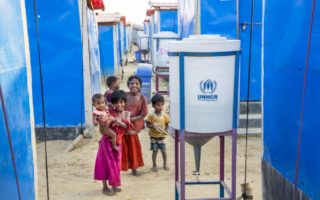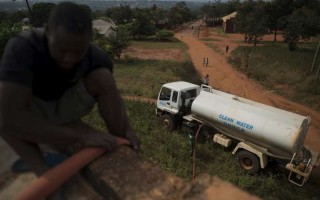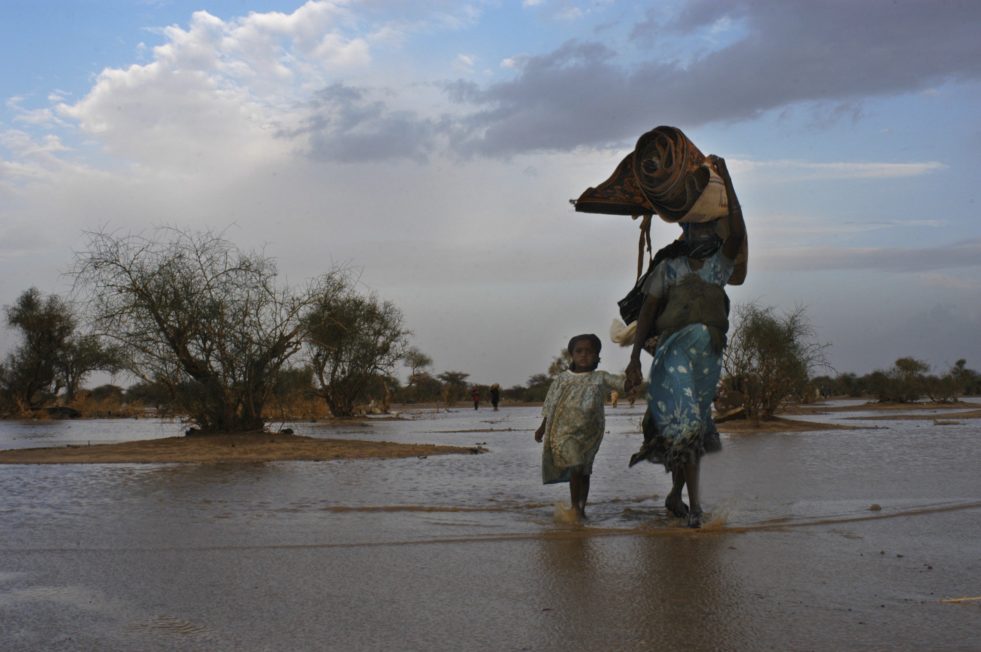
Sudanese refugees from the Darfur region looking for a new shelter in eastern Chad after heavy rains in 2004. © UNHCR/Hélène Caux
Both lack and excess of water can be just as challenging for humanitarian workers
20 litres per person per day — this is the minimum amount of water UNHCR, the UN Refugee Agency aims to provide for every refugee living in a refugee camp. Yet only in 43% of the camps UNHCR is able to reach this essential mark. Climate change is one of the main factors making water supply for refugees more and more challenging every day.
How do 20 litres per person per day compare? On average, an individual in the European Union consumes 128 litres of water per day. In the United States, that figure rises to over 300 litres — for every person, every day.
“Water is essential to survive, but it is also so much more,” Eva Barrenberg, Associate Water, Sanitation and Hygiene (WASH) officer with UNHCR explains. “It is used for drinking and cooking — so that people don’t get sick –, for cleaning and showering, to go to the bathroom, but also to grow plants or animals.”
An individual in the European Union consumes 128 litres of water per day. In the United States, it’s over 300 litres.
It also helps restore refugees’ dignity. “People don’t want to smell bad, they feel uncomfortable. Especially women, when they are menstruating, they want to be able to clean themselves,” Barrenberg adds.
UNHCR has 130 staff working in WASH programmes — only 16% of which are women — spread across the globe, both in camps and urban settings, ensuring that refugees have access to clean water, but also that waterborne diseases like diarrhea or typhoid don’t spread and that basic hygiene needs are met by building sanitation infrastructure like latrines and showers.
“Providing water is not an act of charity, but a fulfillment of a human right.”
“There’s no stronger contribution to improving the life and ensuring the survival of people than water, sanitation and hygiene work,” says Barrenberg, who is very passionate about her work. The job involves engineering skills, but also public health knowledge and lots of social collaboration.
Not having access to water puts people’s lives at risk. “Providing water is not an act of charity, but a fulfillment of a human right,” she says. “It’s just as important as political and civil rights.”
Climate change is making the work of WASH officers increasingly harder. Sometimes it is the lack of water, like in the devastating drought affecting the Chad Lake Basin region; other times, it is the excess of it, like the monsoon rains in Bangladesh. Here’s how UNHCR is working to address those challenges.
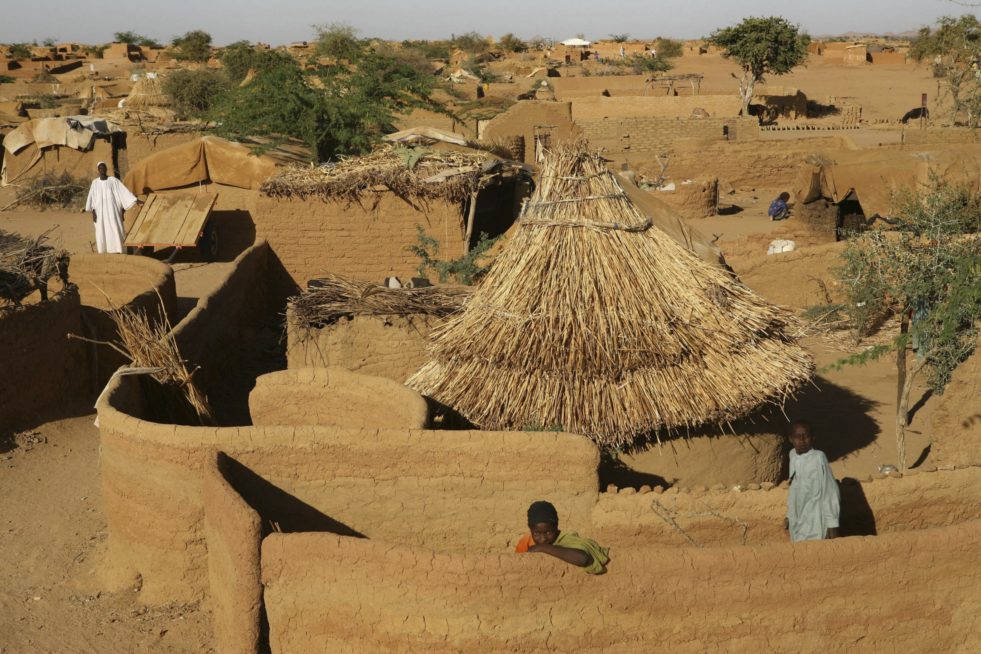
Refugees from Sudan’s Darfur region living in Kounougou camp, eastern Chad, in 2008. © UNHCR/Hélène Caux
Kounougou camp: Building peace by sharing the little water that’s left
Lake Chad is one of the biggest in Africa, but in the last 50 years its water mass has drastically shrunk by 90 per cent — from 25,000km2 to 2,500km2 –, reducing the means of survival for more than 50 million people and driving massive displacement.
As the lake dries down, conflicts have heightened up in the region. Since 2009, the violence of the Boko Haram insurgency has forced more than 2.5 million people from their homes within the Lake Chad Basin.
UNHCR is only able to provide 14 litres of water per person per day in the camp.
These large amounts of people pose additional pressure on the already scarce resources available in such a dry region. “It has more people than the ecosystem can cater for,” Barrenberg says.
Since 2004, thousands of refugees from Sudan’s Darfur region have been spilling over the border looking for safety in eastern Chad, a very arid region. Many of them reached the small village of Kounougou.
Today some 3,500 people live in Kounougou village, while its refugee camp hosts almost 20,000 refugees––mostly Sudanese. UNHCR is only able to provide 14 litres of water per person per day in the camp.
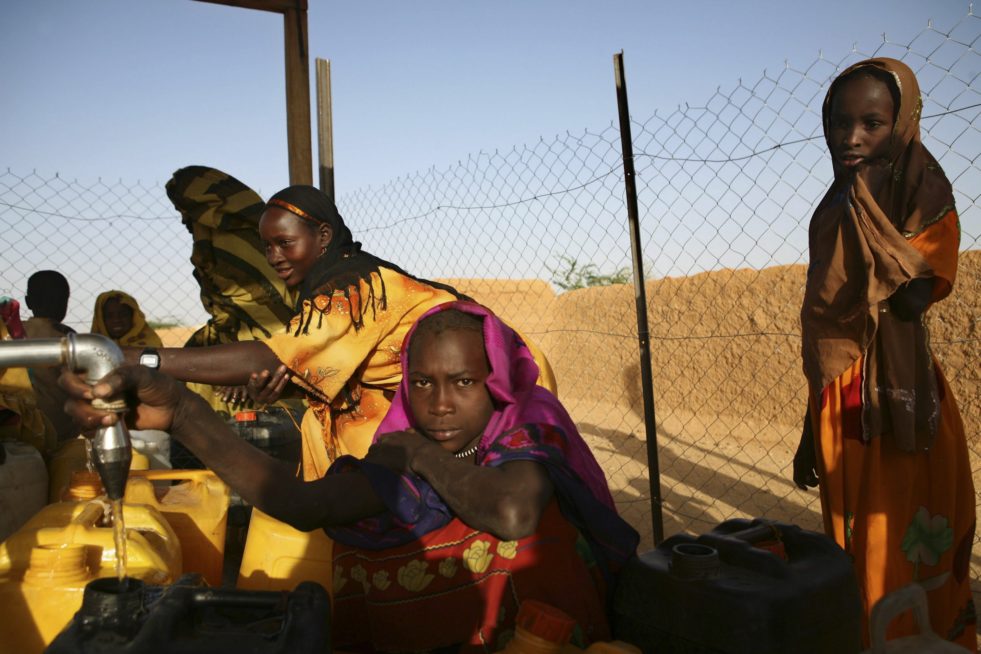
Refugee girls from Darfur gather near a water point in Kounoungou camp in Chad. © UNHCR/Hélène Caux
“It is very hard because suddenly you have thousands of people in this place who need food and water, but not enough local resources to supply them,” Barrenberg adds.
Climate change often acts as a “threat multiplier,” adding tensions that make the work of humanitarian aid more challenging.
Bi Tizie Tre is a WASH officer who has monitored the situation in Kounougou since 2014. During the dry season (October to June), when water supply went below the emergency level of 11 litres per person per day, UNHCR had to rely on trucks to supply enough water for survival to the camps in the region.
“Sometimes we have to bring water with trucks for one month non-stop to reach 11 litres per day,” Tre explains. “It is very costly.”
“When UNHCR brings safe water, it is very appreciated by the local community. It reduces tensions and helps build peaceful coexistence.”
UNHCR prefers to invest in drilling boreholes to create deep wells, because they are a more sustainable solution, Tre explains. Even though they are a big investment with a certain level of risk — usually only one in three boreholes will result in finding enough drinking water — they can become a reliable water source for 20 years.
The fact that water access improved in Kounougou refugee camp created some tensions with the villagers over the years. This is why, between 2009 and 2010, UNHCR drilled four deep wells in the village to ensure that both locals and refugees benefited.
“When UNHCR brings safe water, it is very appreciated by the local community,” Tre says. “It reduces tensions and helps build peaceful coexistence.”
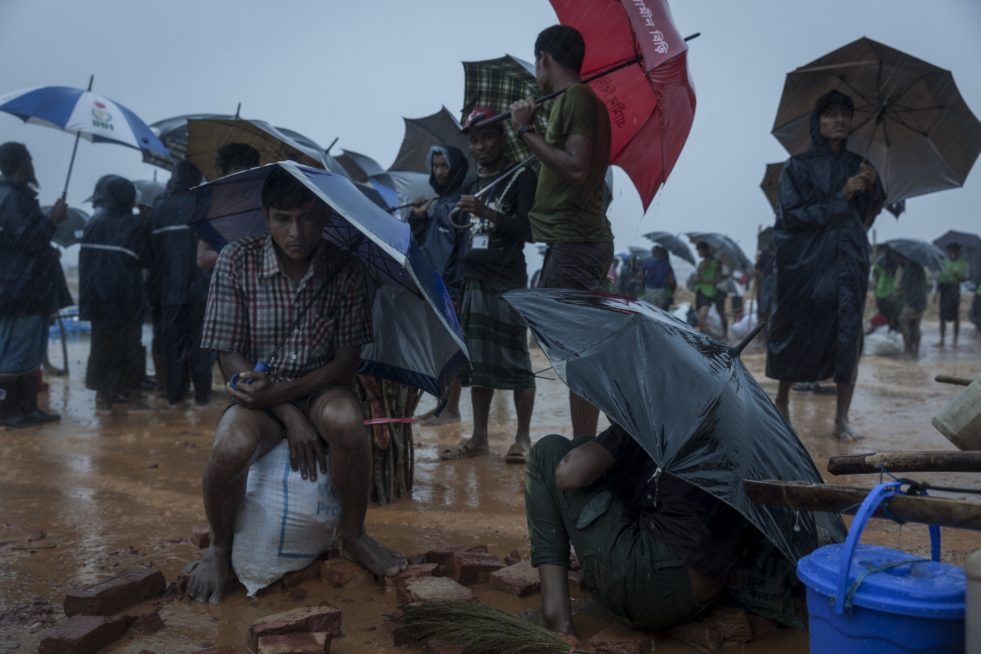
Heavy monsoon rains forced thousands of Rohingya refugees to move to new shelters in Bangladesh in June 2018. © UNHCR/Patrick Brown
Cox’s Bazar: When too much water is also a problem
We tend to associate climate change with drought, but it often involves the opposite — massive, uncontrollable amounts of rain that can kill people, destroy infrastructure and spread diseases.
Monsoon rains are a common — and feared — phenomenon in Bangladesh, which have become increasingly unpredictable, aggressive and deadly due to climate change. In 2018, the country witnessed one of the most furious rainy seasons in years, with rainfall levels in both June and July of over 1,000 mm each — more than half of the average for those particular months.
From a sanitation perspective, flooding generates another big problem — water contamination.
In Cox’s Bazar, the area where over 900,000 Rohingya refugees live across 36 different locations, over 200,000 refugees were exposed to life-threatening landslides and flooding and some 41,000 needed to be relocated to ensure their safety.
From a sanitation perspective, flooding generates another big problem — water contamination.
“Flooded latrines spread fecal matter — and hence infection and disease — across the camp, where people already often live in crowded conditions and are therefore more prone to communicable diseases,” Barrenberg says.
If waste from latrines and other sources filter into the water supplies — boreholes, wells, aquifers or surface water like rivers or dams — they can also get contaminated and spread diseases.
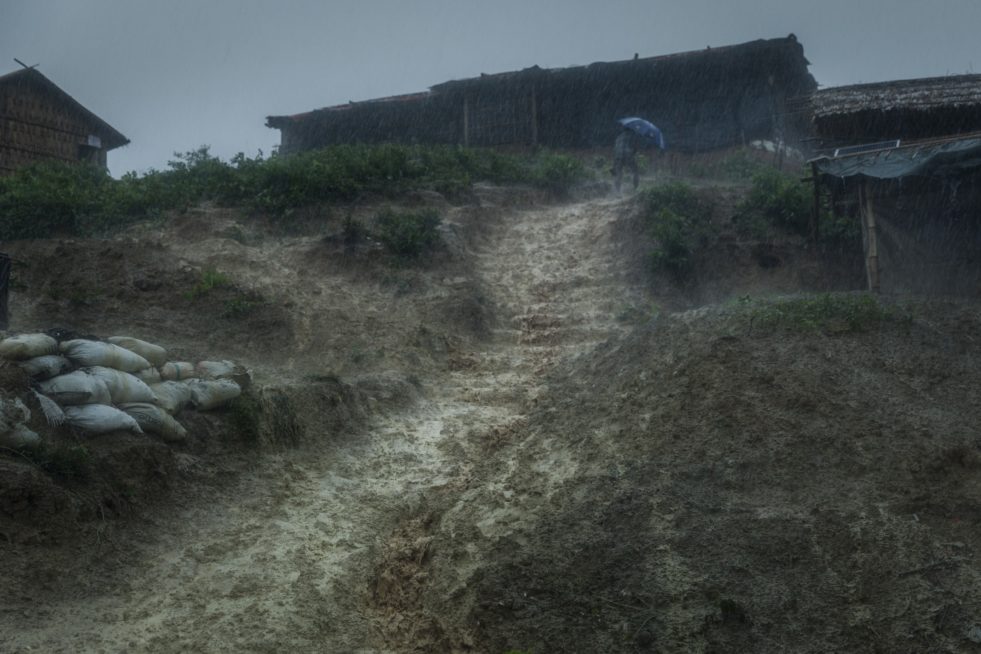
Heavy monsoon rains forced thousands of Rohingya refugees to move to shelters in Kutupalong camp, Bangladesh. © UNHCR/Patrick Brown
A chemical solution — adding chlorine to kill bacteria and microbes in the water — was key to ensure diseases like diarrhoea and typhoid did not get out of control.
“Chlorination is a life-saver in refugee sites of this scale,” says Minhaj Uddin Ahmed, a UNHCR Assistant WASH officer working on the Rohingya refugee response in Cox’s Bazar.
The WASH team in Bangladesh also relied on solar-powered water systems — for pumping and distribution — to improve its efficiency and to ensure they did not depend on other energy sources.
Installing the overhead tanks, solar panels, boreholes and pipe networks required a lot of effort from the community, which has become very invested in the project.
“The community was very cooperative and moved their shelters to provide us with space, which allowed us to install the treatment units,” Ahmed says. “After each installation is complete, both the community and refugees give us regular feedback on the maintenance of the pipe network, tap stands, as well as solar panels, so that we can avoid shortages.”
“If refugees have the right to work, they can pay for water bills and contribute to sustainable water supply.”
About 15% of some 300 mechanised deep wells in UNHCR camps and settlements currently have solar panels installed worldwide. Expanding these eco-friendly systems is a priority for the agency, encouraging host countries to include refugees in existing communities. This way, UNHCR can support water utilities of towns and cities that are hosting refugees and everyone benefits.
“If refugees have the right to work, they can pay for water bills and contribute to sustainable water supply,” says Barrenberg. “This also reduces the risks of climate change, because larger infrastructures can better deal with droughts and floods.”
In late 2017, hundreds of thousands of Rohingyas fled Myanmar in a matter of months — over 700,000. For WASH officers, ensuring potable water for such a massive amount of people was a big challenge.
“At the beginning of the influx, we were able to provide safe drinking water to the refugees despite the large arrival numbers,” says Ahmed. “If it had not been the case, we could have seen a massive outbreak of diseases in the camps. It did not happen. We continue to do so, using more efficient methods and ensuring water quality. This is our greatest achievement and it makes us proud.”
Learn more about UNHCR’s work on Water, Sanitation and Hygiene (WASH).
Written by Marta Martinez.
Originally published on Medium on 21 March 2019



